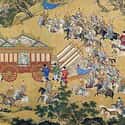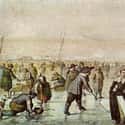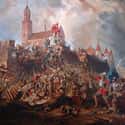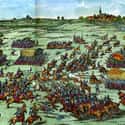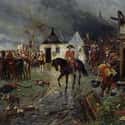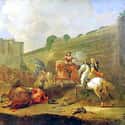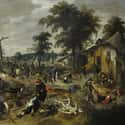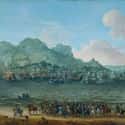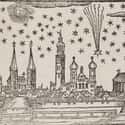-
(#1) China Experienced Famine, A Revolution, And A 50% Population Decline
The Little Ice Age - a period of intense cooling and violent weather change, spanning the 14th through the 19th centuries - had disastrous consequences in China during the General Crisis. Unusual cold and lack of rainfall precipitated an agricultural shortfall and widespread famine. Peasants were hungry and unable to pay taxes, so they revolted against the Ming Dynasty and overthrew their imperial rulers. This allowed Manchurian insurgents to invade the country and establish the Qing Dynasty. It is estimated that 50% of the Chinese population was lost during the unrest, which occurred during the first half of the 17th century.
-
(#2) There Was Literally An Ice Age
The Little Ice Age was a period of cooling that began in the early 14th century and brought global climate change, colder temperatures, and extreme weather events for several centuries to come. By the 17th century, extreme cold and drought impacted cod fishing in the Atlantic, lowered crop production across Europe (inducing famine), and even completely shut down vineyards in England. Glaciers extended to lower altitudes and completely isolated locations like Iceland and Greenland with frozen sea ice. Most European rivers - like London's Thames - and even the Baltic Sea were completely frozen. The coldest period of this centuries-long phenomenon was 1645 through 1715.
-
(#3) There Was A "Deluge" In Which Every Country And Its Brother Invaded Poland
Poland and Lithuania had been able to avoid involvement in the Thirty Years War, but, in 1648, Ukrainian and Cossack elements revolted against the various Polish and Lithuanian noblemen who ruled over the ethnically diverse areas. This event precipitated what was known as "The Deluge," which involved Russian elements in conflict with the Poles and Lithuanians and ultimately resulted in a great loss of territory to Russia after the war concluded almost 20 years later. Sweden, also an emerging regional power, saw this conflict as an opportunity to invade Poland itself, precipitating another bloody conflict that would not be resolved until 1660.
-
(#4) The Thirty Years' War Wiped Out 20% Of Germany
One of the many population-crashing incidents that occurred during the era known as the General Crisis was the the Thirty Years War, a conflict that started in 1618 over religious issues concerning the Holy Roman Empire. By its conclusion in 1848, it would involve every major power in Europe, including France, Sweden, Spain, and Austria. Heavy use of mercenary armies in the War, along with their violet and brutal tactics, led to massive population losses in some places. Among German states, for example, there was a 20% population loss with some areas experiencing a decline of 50%. In 1648, the hostilities ended with the Treaty of Westphalia, but not before populations and industries had been totally wiped out.
-
(#5) The "Time Of Troubles" In Russia Resulted In The Deaths Of Millions
At the start of the 17th century, Russia was greatly affected by the chaos, warfare, and famine happening in and around it. Affected by the agricultural issues associated with the Little Ice Age, famine killed over two million Russians - a third of the nation - between 1601 and 1603. The end of the Rurik Dynasty also fomented political conflict that left the government in chaos, providing an opportunity for an invasion of Russia by Polish-Lithuanian forces who wreaked tremendous destruction until a Russian revolt expelled the invaders. The end of this "Time of Troubles" is traditionally ascribed to the coronation of Michael Romanov as Tsar in 1613.
-
(#6) The Thirty Years' War Caused Food Costs To Increase By 800%
Because of the imminent military conflict of the Thirty Years War, European states, especially in the German region, began to devalue their coins and currency in an attempt to obtain wealth by exchanging this debased money for more valuable coins from other states. Coins previously consisting of gold or silver were now made of copper or even less-valuable metal with no intrinsic value. Economies suffered, trade dried up, and hyperinflation swept through Europe, especially Germany where food costs increased by 800% from 1620 to 1623.
-
(#7) France Experienced Famine And A Revolution Before Its Official Revolution
140 years before the French Revolution, France was gripped by a five-year civil struggle called the Fronde, French for "sling" or "slingshot," which began in 1648. With Louis XIV only 10 years old at the time, the nobility resented the rule of the de facto leader of France, Cardinal Mazarin. Mass unrest began in Paris and spread throughout the country, with high taxes and hunger as two of the major complaints. Eventually, Louis XIV and Mazarin were forced to flee the country. The King would not return until 1652, when the violence subsided - but not before a great deal of death and property destruction.
-
(#8) 35,000 Men, Women, And Children Were Executed In Japan For Rebelling
In 1637, Christian peasants in Japan engaged in what was known as the Shimibara Rebellion. Like lots of other rebellions happening during the General Crisis, this revolt stemmed from famine, high regional taxes, official persecution - including execution by scalding in volcanic pits - and forced labor. The Tokugawa shogunate would eventually put down the revolution and behead over 35,000 men, women and children, essentially the remaining Christians not killed in the bloodshed. Government losses were estimated at double that of the Christian Japanese. Because Portuguese residents were considered the source of Christianity, all Westerners were expelled and forbidden to enter Japan, and Christianity was officially forbidden, policies that would remain in effect for over 250 years.
-
(#9) In England, A Monarch Was Executed And Civil War Spanned A Decade
In 1642, tension between the Monarchical and the Parliamentary (who opposed direct rule by King Charles I) factions of England resulted in an extended period of civil wars. The first of these civil wars would conclude in 1646 with the imprisonment of Charles I and Parliamentarians essentially in control of England. A second civil war broke out in 1648 when Scottish elements attempted to restore Charles I to the throne. This effort also failed quickly and resulted in Charles I's execution for treason in 1649. A third civil war spread to Ireland in 1649 and resulted in the brutal oppression of Catholic "heretics" by a Parliamentary army lead by Oliver Cromwell. This resulted in the confiscation of all Irish Catholic property and its redistribution to English Protestants. Another Monarchical defeat in England at Worcester in 1651 established a united England under the rule of Oliver Cromwell, essentially a military dictator. The estimate of death from warfare or warfare-related disease during these conflicts is about 200,000.
-
(#10) The Dutch Conducted A War Against Spain That Lasted 80 Years
By the start of the 17th century, various Dutch colonial entities had been involved in warfare and rebellion against their rulers, the Kingdom of Spain. This hostility began with religious persecution and oppression, and it resulted in a Calvinist revolt in 1568 that was put down. Over 1,000 heretics were ultimately executed as a result. Continued conflict in the Netherlands would eventually involve the intercession of Elizabeth I and England on the side of the Dutch. King Philip II of Spain would respond with the disastrous Spanish Armada in 1588. Spain would continue to fight a costly war in the Netherlands until a truce was realized in 1609. However, warfare would break out again in 1621 and last until the conclusion of the Thirty Years War and the Peace of Westphalia secured Dutch independence.
-
(#11) The Ottoman Empire Was Devastated By Famine And Warfare
The Ottoman Empire, present-day Turkey, was not immune to the global devastation of the General Crisis. The Empire's population had steadily grown throughout the 16th century, but this trend eventually reversed itself radically. In the first half of the 17th century, some areas experienced population losses of as high as 80%. The decline was so severe that it would take two centuries for the population to return to pre-17th century levels. Internal rebellions and continued defeats at the hands of the Austrians would make life in the Ottoman Empire difficult for much of the century.
-
(#12) Spain Lost Its Status As A World Power
The 17th century introduced a decline, both politically and economically, in Spain. Philip II, the last great ruler of the Spanish Empire, died in 1598. In addition, the Spanish military was greatly affected by the 1588 disaster of the Spanish Armada. Spain's military power would be further diminished by another naval disaster in 1639 as well as defeat at the hands of France in 1643. Plague greatly reduced the population throughout the century, especially in the formerly prosperous towns of Grenada, Segovia, and Toledo, resulting in economic recession. In 1630, Spain had an army estimated at 300,000 men; by 1700, this had been reduced to 50,000.
-
(#13) A Comet Foretold Doom
In 1618, a comet appeared in the sky. Known as the "Great Comet" or the "Angry Star" for its reddish color, the celestial object was visible for more than seven weeks in 1618 and 1619. Astronomers were thrilled with the event, but mystics took it as a fearful sign. Comets and falling stars were often seen as portents of doom, and the Angry Star became an omen for the end of society and the world. Given what happened during the General Crisis, perhaps those believers were right.
New Random Displays Display All By Ranking
About This Tool
Since the 20th century, Western academia has conducted a debate around the general crisis of the 17th century, which has promoted the understanding of early modern European history. The 17th century was a period of such an important and intense crisis. This period was a crucial transition in the development of European society from the Middle Ages to modern society.
The world experienced the economic recession, rising population mortality, bourgeois revolution, social turmoil, and many other social problems, global connections were also strengthened during this period. The random tool described 13 details about the harsh life of the general crisis.
Our data comes from Ranker, If you want to participate in the ranking of items displayed on this page, please click here.











